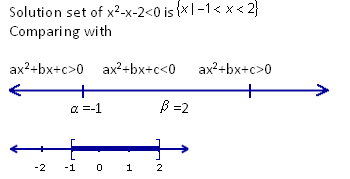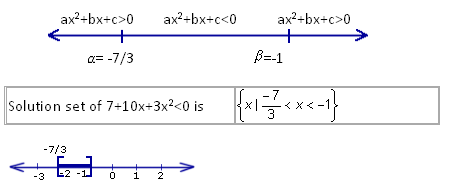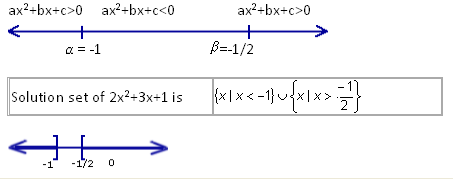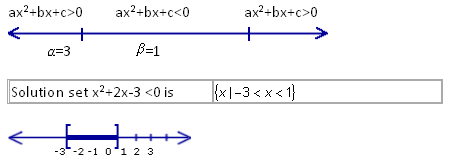We will learn about quadratic inequalities based on the quadratic equation ax2+bx+c = 0, where a≠0, a, b, c are real numbers. The inequalities are of the form

Consider the quadratic equation
ax2+bx+c = 0
The solutions are real and different if the discriminant b2-4ac > 0
Suppose α (alpha) and β (beta) are the solutions (roots, zeros) of
ax2+bx+c = 0
Then, we can write
ax2+bx+c = a(x - α) (x - β)
α,β are real α≠β
Suppose α <β.
Now assume x is moving from the left to the right along the real number line. Consider how the sign of ax2+bx+c
varies in the process.
At the extreme left, x < α < β, then (x -α) < 0; that is, the value is negative and (x - β) < 0; that is, the value is
negative.
In this region, a (x - α ) (x - β) > 0 since a*-ve *-ve = a * +ve
At x = α
a(x -α )(x - β) = 0
When α < x <β
(x -α )> 0 x -α is +ve
(x -α )> 0 x - βis -ve
∴ a(x -α ) (x - β) < 0
a* (+ve) * (-ve) = a * -ve
In this region, a(x -α ) (x - β) < 0
At x = β
a(x -α ) (x - β) = 0
To the right, β for when x >β >α
(x -α ) > 0 x -α is +ve
(x - β) > 0 x - β is +ve
a (x -α ) (x - β) > 0
a* (+ve) * (+ve) = a * +ve
So a(x -α ) (x - β) > 0 in this region.
These results are summarized in the figure given below.
ax2+bx+c>0 ax2+bx+c<0 ax2+bx+c>0

α β
At the points x = α, x = β
ax2+bx+c=0
If a x2+bx+c=0 a>o has real and unequal roots, β then when
x < α ⇒ ax2+bx+c>0
x < α ⇒ ax2+bx+c>0
x = α ⇒ ax2+bx+c=0
α < x < β ⇒ ax2+bx+c<0
x = β ⇒ ax2+bx+c=0
x >β ⇒ ax2+bx+c>0
Now suppose that ax2+bx+c=0 a > 0 has real and equal roots; that is,
α = β = r (say) then when
x< r ⇒ ax2+bx+c>0
x=r ⇒ ax2+bx+c=0
and x>r ⇒ ax2+bx+c>0
This is because
ax2+bx+c=(x-r )2
A square is always positive.
If, however, ax2+bx+c=0 (a > 0) has no real roots then ax2+bx+c>0.
for all real x.
Consider the following examples.
Example 1
Solve x2-6x+8>0 and mark the values on the real number line.
Solution I: x2-6x+8>0
⇔ x2-6x > -8
here a = 1, b = -6, c = 8
By adding (-b/2a) to both sides of the inequality, we get

That is, the absolute value of x-3 should be greater than 1.
∴ There are two possibilities
x-3>1----------------------- (1)
-(x-3)>1-------------------- (2)
Consider x-3>1
⇒ x>1+3
⇒ x>4
Consider -(x-3)>1
⇒ -x+3>1
⇒ -x>1-3
⇒ -x>-2
⇒ -(-x) < -(-2)
⇒ x<2.
The solution set of x2-6x+8>0 is {x/x<2} U {x/x>4}
No value of x lies between 2 and 4.
(check it out)
Solution II: Alternate method
x2-6x+8>0
Factorizing the left-hand side of the inequality
x2-4x-2x+8>0
⇒ x(x-4)-2(x-4)>0
⇒ x(x-2) (x-3)>0
⇔ (x-2)<0 and (x-4)<0
or (x-2)>0 and (x-4)>0
If x-2<0 then x<2
If x-4<0 then x<4
or
If x-2>0 then x>2
If x-4>0 then x>4.
This is possible only if x<2 or x>4.

Example 2
Solve x2-6x+5<0 and mark it on the number line.
Solution:
x2-6x+5<0
Factorizing the left-hand side of the inequality
x2-5x-x+5 <0
⇒ x(x-5)-1(x-5)<0
⇒ (x-1) (x-5)<0
⇒ (x-1)<0 and (x-5)>0
or
(x-1)>0 and ⇒ (x-5)<0
If x-1<0 ⇒ x<1
If x-5>0 ⇒ x>5
Or
If x-1>0 ⇒ x>1
If x-5<0 ⇒ x<5
Or
If x-1>0 ⇒ x>1
If x-5<0 ⇒ x<5

Try these questions
Solve the following inequalities and mark them on the real number lines
x2-x-2<0
7+10x+3x2<0
2x2+3x+1>0
3x2+5x+2>0
x2+2x-3<0
2x2-x-15>0
Answers to Practice Problems
-
Solution:
To solve x2-x-2<0
Factorizing the left-hand side of the inequality we get
x2-2x+x-2<0
⇒ x(x-2)+1(x-2)<0
⇒ (x+1)(x-2)<0
⇒ (x+1)<0 and (x-2)<0
Or
(x+1)>0 and (x-2)<0
If x+1<0 then x<-1
If x-2>0 then x>2
Or
If x+1>0 then x>-1
If x-2<0 then x<2.

Solution:
To solve 7+10x+3x2 <0
Factorizing the left-hand side of the inequality
7+7x+3x+3x2<0
⇒ 7(1+x)+3x(1+x)<0
⇒ (7+3x) (1+x)<0
⇒ 7+3x<0 and 1+x>0
Or
7+3x>0 and 1+x<0.
If 7+3x<0 then 3x<-7
x< -7/3
If 1+x>0 then x>-1
Or
If 7+3x>0 then 3x>-7
x>-7/3
If 1+x<0 then x<-1
Comparing with

-
Solution:
To solve 2x2+3x+1>0
Factorizing the left-hand side of the inequality
2x2+ 2x+x+1>0
⇒ 2x(x+1)+1(x+1)>0
⇒ (2x+1) (x+1)>0
⇒ 2x+1>0 and x+1>0
Or
2x+1<0 and x+1<0
If 2x+1>0 then 2x>-1
x>-1/2
If x+1>0 then x>-1
Or
If 2x+1<0 then 2x<-1
x<-1/2
If x+1<0 then x<-1.
Comparing with

-
Solution:
To solve 3x2+5x+2>0
Factorizing the left-hand side of the inequality
3x2+3x+2x+2>0
⇒ 3x(x+1)+2(x+1)>0
⇒ (3x+2) (x+1)>0
⇒ 3x+2>0 and x+1>0
Or
3x+2<0 and x+1 <0
If 3x+2>0 then 3x>-2
x>-2/3
If x+1>0 then x>-1
Or
If 3x+2 then 3x<-2
x<-2/3
If x+1<0 then x<-1.
Comparing with

-
Solution:
To solve x2+2x-3<0.
Factorizing the left-hand side of the inequality
x2+2x-3<0
⇒ x2+3x-x-3<0
⇒ x(x+3)-1(x+3)<0
⇒ (x-1)(x+3)<0
⇒ (x-1)<0 and x+3>0
Or
(x-1)>0 and x+3<0
If x-1<0 then x<1
If x+3>0 then x>-3
Or
If x-1>0 then x>1
If x+3<0 then x<-3.
Comparing with

-
Solution:
To solve 2x2-x-15>0.
Factorizing the left-hand side of the inequality.
2x2-x-15>0.
⇒ 2x2-6x+5x-15>0
⇒ 2x(x-3)+5(x-3)>0
⇒ (2x+5)(x-3)>0
⇒ 2x+5>0 and x-3>0
Or
2x+5<0 and x-3<0
If 2x+5>0 then 2x>-5
x>-5/2
If x-3>0 then x>3
Or
If 2x+5<0 then 2x<-5
x<-5/2
If x-3 <0 then x<3.
Comparing with
